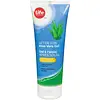What's inside
What's inside
 Key Ingredients
Key Ingredients

 Benefits
Benefits

 Concerns
Concerns

 Ingredients Side-by-side
Ingredients Side-by-side

Water
Skin ConditioningAloe Barbadensis Leaf Juice
Skin ConditioningButylene Glycol
HumectantHydrogenated Polyisobutene
EmollientPEG-8
HumectantPentaerythrityl Tetraethylhexanoate
EmollientCaprylic/Capric/Myristic/Stearic Triglyceride
EmollientGlyceryl Stearate
EmollientPEG-100 Stearate
Triticum Vulgare Germ Extract
Skin ConditioningHordeum Vulgare Extract
EmollientPerilla Ocymoides Leaf Extract
TonicStearic Acid
CleansingTribehenin
EmollientMicrococcus Lysate
Skin ConditioningChamomilla Recutita Extract
Skin ConditioningCholesterol
EmollientIsostearic Acid
CleansingCetearyl Alcohol
EmollientLecithin
EmollientTocopheryl Acetate
AntioxidantBis-Diglyceryl Polyacyladipate-2
EmollientSucrose
HumectantPolysorbate 60
EmulsifyingTromethamine
BufferingDimethicone
EmollientCaprylyl Glycol
EmollientSodium Hyaluronate
HumectantLinoleic Acid
CleansingSqualane
EmollientStearyl Alcohol
EmollientSodium Beta-Sitosteryl Sulfate
Skin ConditioningMagnesium Ascorbyl Phosphate
AntioxidantHexylene Glycol
EmulsifyingCarbomer
Emulsion StabilisingDisodium EDTA
Phenoxyethanol
PreservativeCI 42090
Cosmetic ColorantCI 19140
Cosmetic ColorantCI 61570
Cosmetic ColorantWater, Aloe Barbadensis Leaf Juice, Butylene Glycol, Hydrogenated Polyisobutene, PEG-8, Pentaerythrityl Tetraethylhexanoate, Caprylic/Capric/Myristic/Stearic Triglyceride, Glyceryl Stearate, PEG-100 Stearate, Triticum Vulgare Germ Extract, Hordeum Vulgare Extract, Perilla Ocymoides Leaf Extract, Stearic Acid, Tribehenin, Micrococcus Lysate, Chamomilla Recutita Extract, Cholesterol, Isostearic Acid, Cetearyl Alcohol, Lecithin, Tocopheryl Acetate, Bis-Diglyceryl Polyacyladipate-2, Sucrose, Polysorbate 60, Tromethamine, Dimethicone, Caprylyl Glycol, Sodium Hyaluronate, Linoleic Acid, Squalane, Stearyl Alcohol, Sodium Beta-Sitosteryl Sulfate, Magnesium Ascorbyl Phosphate, Hexylene Glycol, Carbomer, Disodium EDTA, Phenoxyethanol, CI 42090, CI 19140, CI 61570
Ingredients Explained
These ingredients are found in both products.
Ingredients higher up in an ingredient list are typically present in a larger amount.
Aloe Barbadensis Leaf Juice comes from leaves of the aloe plant. Aloe Barbadensis Leaf Juice is best known for helping to soothe sunburns. It is also anti-inflammatory, moisturizing, antiseptic, and can help heal wounds.
Aloe is packed with good stuff including Vitamins A, C, and E. These vitamins are antioxidants, which help fight free-radicals and the damage they may cause. Free-radicals are molecules that may damage your skin cells, such as pollution.
Aloe Barbadensis Leaf Juice also contains sugars. These sugars come in the form of monosaccharides and polysaccharides, folic acid, and choline. These sugars are able to help bind moisture to skin.
It also contains minerals such as calcium, 12 anthraquinones, fatty acids, amino acids, and Vitamin B12.
Learn more about Aloe Barbadensis Leaf JuiceCaprylyl Glycol is a humectant and emollient, meaning it attracts and preserves moisture.
It is a common ingredient in many products, especially those designed to hydrate skin. The primary benefits are retaining moisture, skin softening, and promoting a healthy skin barrier.
Though Caprylyl Glycol is an alcohol derived from fatty acids, it is not the kind that can dry out skin.
This ingredient is also used as a preservative to extend the life of products. It has slight antimicrobial properties.
Learn more about Caprylyl GlycolCarbomer is a polymer of acrylic acid. Its main role is to create a gel consistency.
A high amount of carbomer can cause pilling or balling up of products. Don't worry, most products contain 1% or less of carbomer.
CI 19140 is also known as Tartrazine. Tartrazine is a synthetic dye used in cosmetics, foods, and medicine to add a yellow color.
Tartrazine is created from petroleum and is water-soluble.
Some people may experience allergies from this dye, especially asthmatics and those with an aspirin intolerance.
Learn more about CI 19140Ci 42090 is a synthetic dye created from petroleum. It is used to give a bright blue color to cosmetics, medicine, and food.
Disodium EDTA plays a role in making products more stable by aiding other preservatives.
It is a chelating agent, meaning it neutralizes metal ions that may be found in a product.
Disodium EDTA is a salt of edetic acid and is found to be safe in cosmetic ingredients.
Learn more about Disodium EDTAHexylene Glycol is a surfactant. Glycols are a class of alcohols. Hexylene Glycol is a surfactant and emulsifier.
As a surfactant, Hexylene Glycol helps gather dirt and oil on your skin to be washed away.
As an emulsifier, Hexylene Glycol helps keep water and oil together. This prevents them from separating in a product. Hexylene Glycol also thins out the texture of a product by lessening viscosity.
Hexylene Glycol has a small molecular weight.
Learn more about Hexylene GlycolPhenoxyethanol is a preservative that has germicide, antimicrobial, and aromatic properties. Studies show that phenoxyethanol can prevent microbial growth. By itself, it has a scent that is similar to that of a rose.
It's often used in formulations along with Caprylyl Glycol to preserve the shelf life of products.
Tocopheryl Acetate is AKA Vitamin E. It is an antioxidant and protects your skin from free radicals. Free radicals damage the skin by breaking down collagen.
One study found using Tocopheryl Acetate with Vitamin C decreased the number of sunburned cells.
Tocopheryl Acetate is commonly found in both skincare and dietary supplements.
Learn more about Tocopheryl AcetateWater. It's the most common cosmetic ingredient of all. You'll usually see it at the top of ingredient lists, meaning that it makes up the largest part of the product.
So why is it so popular? Water most often acts as a solvent - this means that it helps dissolve other ingredients into the formulation.
You'll also recognize water as that liquid we all need to stay alive. If you see this, drink a glass of water. Stay hydrated!
Learn more about Water